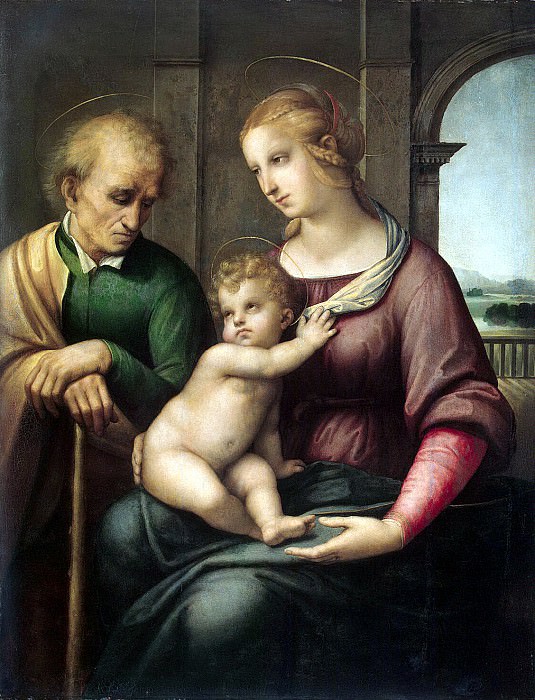Raphael – The Holy Family Hermitage ~ part 10
Hermitage ~ part 10 – Raphael - The Holy Family
Edit attribution
Download full size: 1128×1476 px (0,7 Mb)
Back to album: Hermitage ~ part 10
Raphael was the great Italian Renaissance painter, and "The Holy Family" is one of his early, filigree and subtle works, also called "Madonna with Beardless Joseph." Usually Joseph was depicted with a beard, thus emphasizing his age. Raphael, however, rejected this rule, and in his painting Joseph looks old thanks to less obvious, and therefore more interesting signs of age. His hair is slightly frizzy and dandelion-like, his hands are folded on an old man’s stick.
Description of Raphael Santi’s painting "Holy Family" (Madonna with beardless Joseph)
Raphael was the great Italian Renaissance painter, and "The Holy Family" is one of his early, filigree and subtle works, also called "Madonna with Beardless Joseph."
Usually Joseph was depicted with a beard, thus emphasizing his age. Raphael, however, rejected this rule, and in his painting Joseph looks old thanks to less obvious, and therefore more interesting signs of age. His hair is slightly frizzy and dandelion-like, his hands are folded on an old man’s stick. His mouth is lined with deep wrinkles, and his shoulders are slumped, as if the weight of a hard life were upon them.
Mary and the baby stand in stark contrast to him-they look young, almost radiant in that youthfulness. Mary is simply dressed, her hair tucked under her shawl. The infant in her arms is clinging to her, twisting the way only very young children, who are comfortable in almost any position, can twist.
All together, the three figures form a kind of triangle - take someone out of it and they will fall.
Earthly, family happiness can be seen in them, instead of the usual holiness and longing for icons. They look at each other, seeming like an ordinary family. Mary looks at Joseph with an overlay of quiet sadness, the baby looks at him as if silently asking him something, and Joseph looks at them as if he is longing for that simple, earthly thing that he will never have.
Maybe it is honorable to be the father of the incarnate God, but being the father of your own son is much easier and much happier to get from it.
The painting is dominated by soft, muted colors, flowing smoothly and slowly. There are no harsh lines, no bright spots, no glaring features. Everything is subdued, from the poses, the lines in the faces, to the recurring motifs of the semicircle and arch.
The halos above the heads are barely hinted at, and this is understandable - Raphael was not just portraying saints, but was looking for a man in holiness.
Кому понравилось
Пожалуйста, подождите
На эту операцию может потребоваться несколько секунд.
Информация появится в новом окне,
если открытие новых окон не запрещено в настройках вашего браузера.
You need to login
Для работы с коллекциями – пожалуйста, войдите в аккаунт (open in new window).




















COMMENTS: 2 Ответы
Очень жаль что в Эрмитаже только одна картина Рафаэля. Я имел счастье лицезреть его Даму в сиреневом... на выставке посвященной 200- летию Эрмитажа, более того мне достались 2 экземпляра каталога, которые я подарил искусствоведам Украины /сожалею/ Ибо теперь знаю, что Рафаэль Сантос и его Дама... Это и есть вершина изобразительного искусства, после них все пошло в низ
Почему только эта? А "Мадонна Конестабиле"?
You cannot comment Why?